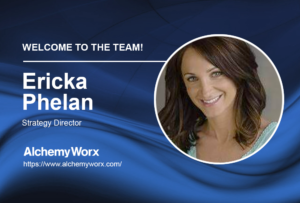
Crafting Concise and Effective SMS Copy for Clients
“When will you be home?” It’s got all the hallmarks of a perfect text; It’s short, sweet, and lets the reader know exactly what is

“When will you be home?” It’s got all the hallmarks of a perfect text; It’s short, sweet, and lets the reader know exactly what is

Months of audience management and offer optimization fuel soaring holiday sales for this beauty brand. Read this case study to see how we partnered with

Phelan brings incredible retail marketing experience and track record of success using CRM and email as key revenue drivers for top brands to Alchemy Worx.

“When will you be home?” It’s got all the hallmarks of a perfect text; It’s short, sweet, and lets the reader know exactly what is

Months of audience management and offer optimization fuel soaring holiday sales for this beauty brand. Read this case study to see how we partnered with

Phelan brings incredible retail marketing experience and track record of success using CRM and email as key revenue drivers for top brands to Alchemy Worx.

Untested subject lines are a crapshoot. Like many things in life, subject-line performance falls on a bell curve. Some perform exceptionally well. Most are average
Building a cumulative advantage is a process that requires precision and perseverance. In Part I, we discussed the importance of becoming popular early and some methods that have proven effective, and we also addressed consumers as creatures of habit, stressing the significance designing your brand experience for habit. The evolution of technology is responsible for creating new consumer habits – for our purposes, digital habits. In this segment, we’ll address these habits, discuss the dilemma of changing your brand, and conclude with how to effectively communicate with your following.
It goes without saying that customer acquisition is vital to the success of any business in the retail and media spaces.
We are creatures of habit. From the moment we get up in the morning, our habits begin to affect how we function. Think about your morning routine – the order in which you perform your daily rituals. Whether it involves hygiene, beverage of choice, breakfast, reading materials, or checking your social channels, there is a developed tendency that provides order and comfort. This concept of how habits are formed, as it relates to branding, is something we should explore.
So, last-click attribution fails to give email it’s proper credit for the sales it drives. So what? Why should anyone care? The sales are still happening. Well, if email is driving more sales than it’s getting credit for, then folks across all of marketing and sales should be interested in rectifying the issue. Why? Because proper attribution clarifies how the various sales and marketing channels support one another. For example, suppose for an offline/online retailer, email drives more bricks-and-mortar purchases than it is given credit for. Hint: It pretty much always does.
In Part I, we examined the buying process, giving insight into why consumers buy and the behaviors exhibited before, during, and after purchases are made. Now, let’s talk about the impact of sales. Everybody loves a good sale. But why?
Consumers like to feel smart. Any sense of achievement when shopping is a feather in their cap. The science of the sale is simple – it hypes consumer emotions. When people have emotional reactions, it’s something they want to talk about it. In retail, when they talk about it, it generates a buzz. It’s a simple process: Show value to your customers. They’ll engage and feel accomplished.
A simple review of daily sales figures has just shown that on days during which the company sends a lot of email, there is a significant boost in sales across all channels that can’t be accounted for any other way than email’s so-called halo effect. Since everyone in the organization presumably leaves their warm bed in the morning to make as much money as possible, the next move is simple, at least in concept: Make every day a high-volume email day.
When it comes to commercial email there are usually two camps in a typical organization: the folks in sales who need to make their numbers and who tend to want to send more email, and the folks in marketing who want to protect the brand and who get squeamish about the possibility of annoying customers with too much messaging.
Engagement. With the possible exception of relevance, it is arguably the most overused word in email marketing. Engagement became a hot topic in 2012 when deliverability professionals began touting it as a necessity for continuing to reach subscribers’ inboxes. Their argument went that the criminal spam issue had largely been solved with filtering technology. As a result, they said, email inbox providers were going to turn their attention to the next problem: commercial senders with large, largely inactive files.“
What do peas, Italian wealth in the early 1900s and email house files have in common? The 80/20 rule.
Unfortunately, the 80/20 rule leads a lot of email marketers to punish 80 percent of their file out fear of disrupting the behavior of the 20 percent. Marketers learn early in their careers—often in business school—about the 80/20 rule and how it applies to business: 80 percent of a company’s revenue is typically driven by 20 percent of its customers.